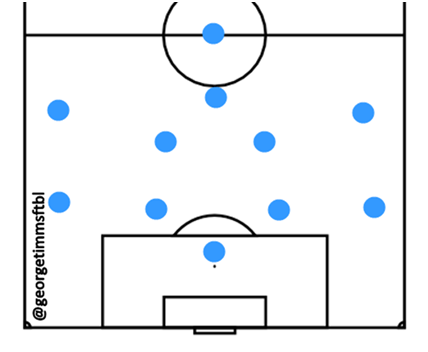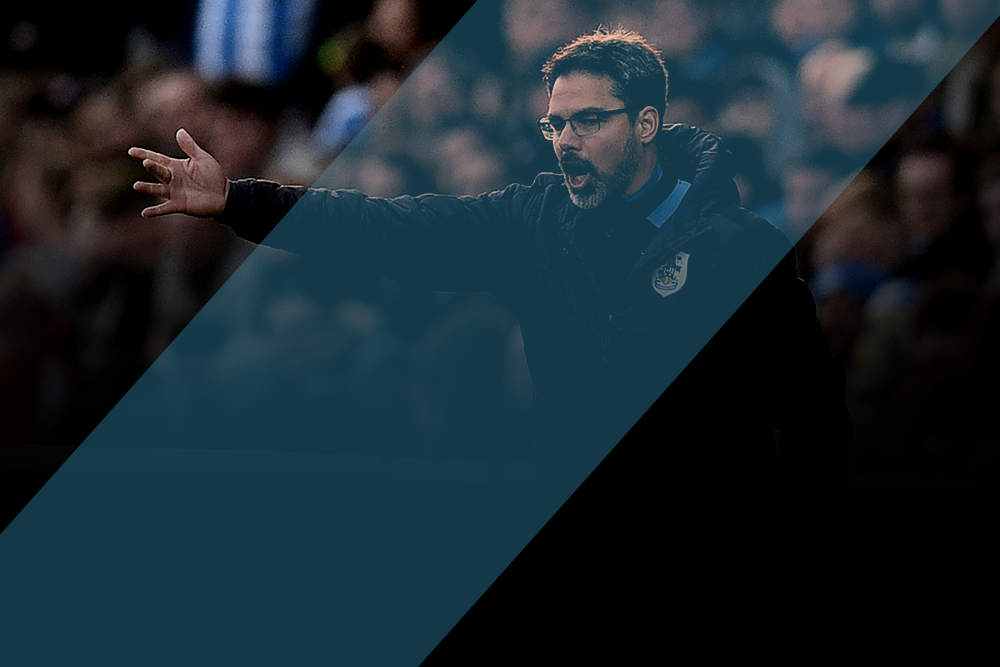George Timms takes a close look at Huddersfield Town and the factors that have propelled them to the top spot in the Championship.

After finishing 19th and 11 points above the relegation zone in 2015/16, Huddersfield Town find themselves positioned 1st in the Championship after 8 games, winning 6, drawing 1 and losing 1. This therefore is a surprisingly exceptional start, especially when the lack of financial power Huddersfield have behind them (producing the 21st highest revenue in the Championship out of 22 teams in 2014/15) and the competitiveness of the division are considered. Yet following the appointment of David Wagner in November 2015, the club’s fortunes have been on the rise.
The Manager
Huddersfield have been dubbed the ‘Baby Liverpool’ by some, and it isn’t hard to see why. Not only does David Wagner have the same nationality (German), definitive delicate glasses and beard and baseball cap appearance as the Liverpool manager Jurgen Klopp, Wagner was a colleague and understudy to Klopp at German giant Borussia Dortmund between 2011-2015 as manager of the second team, Borussia Dortmund II. Wagner is now a good friend of Klopp, and was the Liverpool manager’s best man at his wedding! As a result, Klopp’s philosophy has been instilled on Wagner, and their teams play a very similar brand of football. High energy football, with emphasis on ‘gegen-pressing’ (counter-pressing), winning second balls and attacking fluidity, speed and balance make up the essence of the pairs’ philosophy. This system requires a particular type of player in each position to adapt to and thrive in this system, traits such as stamina, tactical intelligence and smart decision-making are essential for all players. Klopp developed this at Dortmund (and is currently developing at Liverpool), whilst Wagner is in the early stages of implanting this at Huddersfield.
The manager recruited no less than 13 players from across the continent this past summer, some of the most notable being Aaron Mooy, Chris Lowë, Kasey Palmer and Danny Ward. The new players have been implemented into the manager’s system with startling speed. Pre-season consisted of a tour of Sweden, where the players were able to spend time with each other and bond quickly. Consequently, the team’s early success in the 2016/17 season was accredited to the squad’s tight bond as a result of the Sweden trip by Wagner himself. Notable clean sheets for matches against Bundesliga sides Werder Bremen and FC Ingolstadt 04 were also part of The Terriers pre-season, providing the foundations for their excellent start to the season.
The System
Town’s core formation is a 4-2-3-1, that transitions into a 2-4-3-1 in attack, and a 4-4-1-1 in defence. When attacking, the wingers play primarily as inside forwards, offering support to the striker in central areas of the pitch, whilst full backs push high, offering width and stretching the pitch.

This fluidity between phases of play and positions is important for a variety of reasons. Firstly, the high proximity of players to the centre of the pitch allows quick combinations between players, primarily through short passes and third man runs. This active and energetic interplay disorganises the opponent, creating space and passing lanes in the defence to exploit, allowing penetrative attacks through the centre of the pitch.
The 2-4-3-1 shape is effectively ‘defending with the ball’, and allows Huddersfield to defend the way Wagner desires. The nature of the 2-4-3-1 shape positions players high up the pitch, meaning the players have a close proximity to opposition players. Less ground has to be covered to close and press them, as if the ball is lost by Huddersfield high up the pitch, the players are in position to press the ball immediately after losing it therefore possession is more likely to be won, whether that be through a direct tackle of the opposition ball player or by forcing them to play a long ball over the top for the Huddersfield defence to claim. Huddersfield’s shape allows them to press the ball in numbers in an organised manner, with waves of pressing providing layers of pressure. The central positioning of the wingers almost leaves Town with 3 strikers, allowing opposing centre backs to be pressed in a more compelling fashion. Due to the majority of English teams playing with 2 centre backs, this often leads to opposing centre backs finding themselves outnumbered 3 v 2 by the Huddersfield striker and wingers. The central positioning of these 3 most advanced players accompanied by the central attacking midfielder and the 2 centre midfielders in behind means that Huddersfield possess sufficient man-power to leave few opposing players unmarked in central areas, whilst limiting space and potential passing lanes available to exploit. This forces the opposition to either play an inefficient long ball towards the striker(s), where they are outnumbered by Huddersfield’s defenders, or to pass wide and build up through the full backs, which immediately reduces the options to progress play and is a trigger for an aggressive Huddersfield press.
 The above diagram shows why so many modern teams such as Huddersfield have implemented pressing triggers when the ball is played into wing channels by the opposition. The pitch has been divided into 5 vertical channels, the centre, 2 half spaces and 2 wings. The black dots in each zone represent the positioning of a player in possession of the ball.
The above diagram shows why so many modern teams such as Huddersfield have implemented pressing triggers when the ball is played into wing channels by the opposition. The pitch has been divided into 5 vertical channels, the centre, 2 half spaces and 2 wings. The black dots in each zone represent the positioning of a player in possession of the ball.
The player in the central zone has the most passing options available to him. He can pass to a player in the same central channel as him or either side’s half space or wing most often through a more accurate and less time consuming shorter pass. The player situated in the half space can again pass to either side, but can only has the wing area to pass to on one side, with 3 channels available on the other side. The furthest of these is the opposite wing, which would require a long pass to complete a passing connection with a teammate in this channel. This however requires greater accuracy and execution, whilst also taking longer to travel to the intended target, creating time for opposing defenders to mark this teammate, or to intercept the pass resulting in a loss of possession. Crucially however, the player located on the wing cannot pass to either side of him. Due to the boundaries of the pitch, he can only pass to a teammate in the same wing channel as him, or inside towards central areas. This is often difficult due to the proportion of players on both teams here, meaning unmarked players, space and passing lanes are scarce. For the player to complete a pass to a teammate in the opposite wing channel would call for an unlikely occurrence, such as a defensive player slipping over. This is due to the time it would take to reach this channel, as well as the incredible accuracy and execution required of the pass.
These limited options in wide areas are the reason behind the pressing trigger. Once pressure is applied from central zones of the pitch, the player on the ball in the wing channel cannot retreat away from the centre due to the close proximity to the touchline, which if crossed would result in a loss of possession. This often leads to being presented with limited time on the ball, resulting in being dispossessed by a tackle, or by playing an inefficient long pass, such as a cross into the box, one of the least efficient methods of chance creation in football.
Pep Guardiola – “The touchline is the best defender in the world”
The player on the wing would be unlikely to shoot, as he would be located far from the opposition goal with a very tight shooting angle, making scoring incredibly improbable.
The positioning of Huddersfield’s players allows them to force and lure opponents into wide areas, whilst possessing the necessary structure to use ball-orientated shifts to press them effectively.

As the yellow areas highlight, the 2-4-3-1 provides 2 clear pressing waves, whilst also granting fluidity to allow movement between pressing waves when necessary. If the initial pressing wave of the front four players is broken through, the two central midfielders and full backs are close behind to provide the second layer of support, limiting space between the layers of Huddersfield’s defensive structure.
On the occasion that the press is broken, and the opposition enter Huddersfield’s half of the pitch, the team form a 4-4-1-1 as pictured below.

Two deep banks of four limit space between the lines, making central areas difficult for the opposition to operate in. The 2 wingers, central attacking midfielder and striker act as passing outlets once the ball has been regained, meaning pacey counter attacks can be used to exploit the opposition in transition.
Back to pressing. By operating centrally, the wingers and striker are able to occupy the opposing centre backs, limiting access to the centre of the pitch. In order to progress play out of defence and retain possession, the opposition are forced into passing to the full backs in the wide channels of the pitch.

In the above scenario, the right back has the ball, which has triggered Huddersfield’s press. The Huddersfield left back has moved into the first pressing wave to limit the right back’s progress down the touchline. The ball-near winger is the man to press the right back, meaning the Huddersfield ‘No.10’ must drift towards the ball to mark the opposing ball-side central midfielder, limiting central passing outlets. Due to his positioning, the striker is able to curve his press into the right back’s cover shadow, meaning the press from behind the right back will be unseen. This also reduces his passing options, as the striker is able to occupy the passing lane that would be used by the right back to pass backwards to the centre backs or goalkeeper.

As this scenario has progressed, the right back is inundated by Huddersfield players, He has no short passing options, whilst long passing options are also limited. The Huddersfield centre backs have shifted to the ball-side area of the pitch, meaning long vertical passing options are unlikely to be completed, as the ball side winger and striker are occupied. If the right back was to switch play, the distance it would take for the ball to reach the opposite side of the pitch would provide time for the Huddersfield players to quickly shift their structure to the other side of the pitch, meaning that the same conundrum could easily be created for the opposition on the other side of the pitch.
These limited options for the opposition as a result of Huddersfield’s sophisticated defensive structure and patterns have been problematic for Championship opponents, resulting in situations where possession is regained more often than not, and a new attack can be devised.
The Players
As previously stated, for Wagner’s Huddersfield to play the way he envisions, he needs specific players to fit his system. By adding to Huddersfield’s current crop of players with 13 new summer signings, progress has undeniably been made towards this objective.
Whilst being unable to make a lasting impression at his parent club Liverpool, 23 year old loanee goalkeeper Danny Ward has reinforced The Terriers’ defence with a new found sense of stability. Though Huddersfield have consistently failed to keep clean sheets, their opponents have failed to score more than 1 goal against the Championship leaders so far this season. Whilst centre backs Christopher Schindler and Mark Hudson have also contributed to Town’s opponents lack of goals, they are also both capable of aiding ball circulation through defence and progressing possession through into midfield. This is the case chiefly for Schindler, who plays 4.3 long passes a match, whilst maintaining an 85.2% total pass completion percentage. Full backs Tommy Smith and Chris Lowe fulfil there roles as complete wing backs well, exhibiting the stamina and positional intelligence to offer width in attack, whilst also being defensively sound. Schindler and Lowe are two of Wagner’s German recruits, who have been able to fit into his system with relative ease due to playing similar style football to Wagner’s ideals in Germany. This is especially the case with Lowe, who has experience playing for Wagner prior to joining Huddersfield at Borussia Dortmund II.
In this 4-2-3-1 system, the two central midfielders must execute specific duties to play Wagner’s way. A box to box midfielder and a deep-lying playmaker compliment each other well in this formation. The pair offer balance, organisation and stability in both attack and defence. The deep-lying playmaker offers vision, creativity and penetrative passing ability in order to create chances and penetrative moves from deep areas, whilst also offering a feel of defensive stability due to his positioning. The box to box midfielder offers support at both ends of the field, and is particularly effective in Wagner’s system due to his ability to create overloads in attacking areas, aiding the progression of passing combinations and ability of others to make third man runs. They also provide a separate layer of third man runs from central areas and counter-pressing pressures. When played correctly, these two players can be particularly influential on the team, particularly in attacking transition, making pivotal passes resulting in dangerous counter attacks.
Undoubtedly one of the most influential players in the team, Aaron Mooy executes the deep-lying playmaker role splendidly, especially for a Championship outfit. Previously of Melbourne City and now Manchester City, the Australian loanee has controlled the tempo of Huddersfield’s attack well, possessing the tactical intelligence and ability to read the game to know when to speed up play, and also when to slow it down. Mooy completes an average of 73.3 passes a game for Town, including 1.5 key passes, showing he is able to play a role in the development of goal-scoring chances. He is a capable of battling for aerial duels, whilst also being a long-shot threat and competent tackler, averaging 3.0 per game. It is a shame Mooy is only playing in Yorkshire for a single season, as he has been a very strong addition to Town’s midfield. His central midfield partner is Jonathan Hogg. Hogg possesses a good work rate, advocating attack and defence. He averages 66.6 passes, in addition to contributing 2.6 tackles per 90. This shows how much Mooy and Hogg contribute to all phases of play, complimenting each other well in the process.
The 3 attacking midfielders performance’s in behind the lone striker, Nakhi Wells, have only been getting better and better as the early stages of the season have progressed. Kasey Palmer, with Elias Kachunga and Rajiv van La Parra either side of him have been excellent. The quarter possess the physical attributes, such as speed and stamina to play the high tempo football Wagner envisions, whilst also being astute enough to interchange positions, disrupting the opponents organisation. This is again where comparisons to Klopp’s Liverpool are made. Huddersfield’s attack is occasionally reminiscent of Liverpool’s interchangeability and fluidity between players such as Roberto Firmino, Adam Lallana, Sadio Mane and Daniel Sturridge. Liverpool have been firing on all cylinders at times so far this season, and the fluidity in attack has led to goals being well distributed across the forwards and midfielders, which has also been the case so far at Huddersfield, with Kachunga, Wells, van La Parra, Palmer, Mooy and Hogg all on the score sheet so far, Kachunga being the highest scorer with 3. Kachunga, another German on loan from FC Ingolstadt 04, is the most versatile of Huddersfield’s front quarter, as he is able to play on the right wing in addition to striker, facilitating the way for Nakhi Wells, to lead the line, an established football league goalscorer, scoring almost a goal every two games at Bradford between 2011-2014 preceding his transfer to Huddersfield. Kasey Palmer had never played a senior game of football previous to his loan move from Chelsea where he had an impressive youth career. Despite this lack of experience, the 19 year old scored on his debut, and has since added another to his senior tally. Palmer has been a dangerous player for Town, especially since hid implementation into the starting line-up after a number of substitute appearances. His pace, agility, dribbling ability and movement are disruptive to opposing defences, and it will be very intriguing to see if he can build on his early promising performances and become a consistent problem for Championship opponents this season. His rapid development may sustain under Wagner, a manager with a history of leading young players in the right direction at Borussia Dortmund. This may perhaps earn himself a chance in Antonio Conte’s first team next season. Rajiv van La Parra has a tendency to dribble and run at the defence, averaging 4.3 a game, especially when isolated one on one. Though this can be erratic at times, he can be troublesome to Championship defences, getting fouled 1.4 times per 90, and can lead to pacey crosses/shots in and around the box. Though on a season-long loan from his parent club Wolverhampton Wanderers, Huddersfield possess the option to make the deal permanent next summer.
As a total system, the players fit Wagner’s philosophy, and play as a fluid and cohesive unit in all phases of play, despite having limited experience playing in this tactical system and with each other.

Conclusion
Whilst the 4-2-3-1 formation is fairly common in modern English football, the way the players position themselves in different phases of the game (attack, defence, attacking transition and defensive transition) is uncommon and fresh to English football, especially to the Championship (Klopp introduced a similar system a year earlier in the Premier League at Liverpool). Wagner’s tactics are more sophisticated than what a typical English side would implement, and is a new obstacle for Huddersfield’s Championship opponents to overcome. They will have to attack and defend against Wagner’s side in an unfamiliar manner, as the majority of teams Huddersfield will face this season will not have played against a team like them previously.
This therefore may partially be a factor towards Huddersfield’s early success, as opponents don’t have the sophistication or adaptability within their own tactical systems to overcome Huddersfield’s originality in both attack and defence. It is sure to be a fascinating season for The Terriers, where the sustainability of their success is indeed questionable. This is due to their lack of financial power, opponents eventually adapting to Wagner’s system and the unpredictability and competitiveness of the championship, where any one team can beat another. Regardless, it is going to be an exciting season for the John Smith’s Stadium faithful, where success may well be a realistic possibility for David Wagner’s Huddersfield Town.
- Analysis: How Huddersfield Town are top of the Championship - September 23, 2016























































